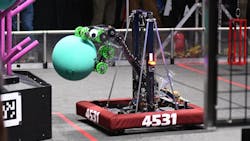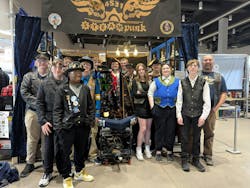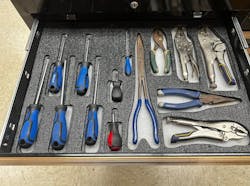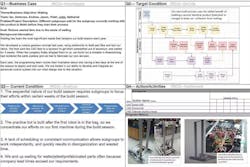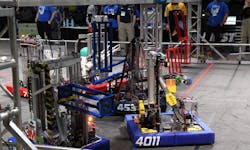How Lean and Agile Help High School Team STEAMpunk Build a Better Robot
STEAMpunk is a team of Wisconsin high school students in Manitowoc County who build robots to compete in the FIRST Robotics Competition. Our manufacturing process allows us to develop robots that routinely rank in the upper third in our regional competitions (which can comprise 55 or more robots).
However, it wasn’t always this way. Prior to 2018, our robot ranked in the lower third of our regionals – after which, we started implementing lean and later, agile.
This article shares how the team operated prior to implementing lean in 2018, as well as how we operate since implementing seven lean and agile initiatives – 6S, VSM, 8W, flow production, A3 documentations, stand-up meetings, and user stories – to develop a more effective robot to compete in our regionals.
Although this is my rookie year on STEAMpunk, I’ve pushed the team to adopt more lean and agile scrum management – with a strong emphasis on agile. Even as our team strives for our lean and agile practices, we sometimes still struggle with the same goals we’ve been striving for since 2018.
How We Operate
STEAMpunk is a member of the Lakeshore FIRST Robotics program. Our team is run like a business, with several student captains forming their own management group based on their talents. Each season, we have six weeks to design, prototype, CAD, fabricate, assemble, wire, code, test and reiterate a robot that weighs upwards of 175 pounds.
Prior to 2018 and the implementation of lean, STEAMpunk’s inefficient processes limited our team’s ability to develop a competitive robot in those six weeks.
Key Problems Before Lean & Agile Scrum
To quote a former STEAMpunk member on what this team was like prior to the implementation of lean, “STEAMpunk was a disorganized mess.”
Our team struggled with basic organization and waste/resource management. To put it simply, without the lean and agile practices we implemented throughout the years, our team wouldn’t be nearly as streamlined as it is now. Key issues our team struggled with:
1. Resource management
- Cheap, low-quality tools often broke.
- Disorganized storage meant tools frequently were misplaced.
- No system existed to track missing tools, leading to last-minute shortages.
2. Poor organizational structure
- No clear roles and responsibilities—subteams operated in silos.
- Lack of training meant only a few members could fabricate key components.
3. Communication and collaboration gaps
- No structured meetings meant that subteams were unaware of each other’s work.
- Conflicting designs led to defective parts that had to be remanufactured.
- No real-time updates on roadblocks led to wasted time.
4. Workflow inefficiencies and waste
- Mechanical fabrication consumed 50% of the six-week season, leaving only two days for programming and electrical work.
- Long waiting times existed between subteams due to poor coordination.
- Limited documentation of mistakes led to repeated errors every season.
The Implementation of Lean and Agile, Beginning in 2018
6S and Visual Management
Our 6S initiative was to organize pre-manufactured parts, scrap metal and tools. STEAMpunk did two things when it came to tools:
- Over time, our team got rid of the cheap, low-quality tools and replaced them with quality tools and placed them in higher quality toolboxes. (We funded this from the ‘build’ budget Lakeshore FIRST Robotics provides to the team each year.) Toolbox drawers also were labeled with what tools they would contain (cutting, drill bits, pens and marking, etc.).
- Our team organized hand tools into foam-boarded liners, which both streamlined grabbing tools—locating tools is now six times as fast—as well as highlighted when tools were missing.
Additionally, pre-manufactured parts and scrap metal were organized into separate, labeled bins, instead of using one bin for all metals, making it easier to find what we were looking for.
Value Stream Mapping (VSM) and Eliminating Waste (8W)
VSM showed us how one part of the design process was taking up a significant amount of time. Using kaizen bursts paired with VSM, our team identified that the mechanical portion of our season – which would be prototyping, CAD-ing our parts and manufacturing them – was taking 50% of our season, leaving us with 5% of the season to program and wire our electrics. This meant critical parts of the robot were significantly underdeveloped due to a lack of time. Realizing how critical it was to reduce the time it takes for our robot to be developed mechanically, we began creating A3 documentation to address the root issues of our mechanical process.
Using A3 documentation, we established the root cause of why our mechanical portion of the robot took so long. It was the team members’ inexperience, paired with a lack of communication. Asking inexperienced team members to make parts that required a high tolerance led to a high rate of defects and required a redo for the parts.
To combat these wastes, our team created specific preseason training for newer members to share information on how to operate specific machinery and how to tackle certain problems. For example, for more advanced machinery like the Haas milling machine (which is required for high-tolerance parts), students got hands-on experience with operating the milling machine, consulting CNC programming language, consulting the Haas handbook, etc. This gave them the knowledge they needed to accurately use the Haas milling machine during the season.
How We Improved
Tooling & 6S Efficiency Improvements
Foam cutouts and visual bins cut average tool/part retrieval from 40 seconds to five seconds, which is especially impactful during mechanical prototyping. Over the season, this saved an estimated 1.25 hours.
Agile Structure & Subteam Communication
Implementing agile scrum improved clarity across subteams. Defined roles and user stories reduced task overlap and helped cut 8W defects.
Daily stand-up meetings aligned teams and shortened miscommunication-related delays, leading to faster problem resolution.
Training & Skill Development
Preseason training in CAD, programming, electrical and lean principles equipped new members, increasing task readiness. In addition, returning members refreshed skills through targeted workshops, which increased early-season output.
Lean, VSM & Process Optimization
Using VSM, we identified mechanical as a bottleneck. With A3 documentation and kaizen bursts, we reallocated time to programming/electrical without sacrificing quality and reduced mechanical delays by 50%. These continuous improvements led to a more balanced and efficient workflow.
Before the start of the season, STEAMpunk also made it a priority that everyone on the team was well-equipped to perform any task that they could be assigned. Our team created training for key skill areas: CAD, programming, electrical, safety, business and marketing, lean and even imagery. This knowledge sharing helped remove a significant amount of 8W by building talent and giving our members versatility in the tasks they could accomplish, saving an exceptional amount of time.
Stand-Up Meetings
One of the most significant ways our team improved communication is through five-minute stand-up meetings at the start and end of each work session. At the start of the session, each subteam shares what it accomplished at the last work session and what it plans to accomplish during the current session. At the end of the meeting, each subteam shares what it accomplished, along with any wastes/blocks that were encountered.
With the stand-up meetings, subteams are now completely aware of what other subteams are doing. That wasn’t always true before. With this change, the manufacturing team can manufacture parts for multiple subteams at once. This utilizes talent wisely, minimizes delays and reduces total defects.
User Stories
We introduced agile user stories to help our team focus on what is important for designing and producing mechanisms for our robot. By clearly defining criteria that each mechanism must meet to be considered successful, user stories give us a structured way to break down complex mechanisms into smaller, more manageable parts. This approach not only ensures we stay aligned with project goals but also provides an easy to understand and teachable framework that makes it simple for new team members to contribute from the start.
Our 2025 Season
Our 2025 robotics season was a highly accomplished one. We finished 13th at the Northern Lights Regional in Duluth, Minnesota, and 8th at the Seven Rivers Regional in La Crosse, Wisconsin, serving as alliance captains at both events. At Seven Rivers, our team also hosted a lean and agile workshop, giving Wisconsin teams the opportunity to explore how they could apply these principles within their own teams. We are honored to be invited to the inaugural Wisconsin State Championship as one of the top 32 teams and look forward to continuing to share lean and agile strategies with others across the state.
The Future
We are currently refining subteam training for next season and our design process to apply agile scrum to more prototyping applications. Along with this, we plan to give talks about lean and agile to other teams at an off-season competition in the Milwaukee area.
One of STEAMpunk’s main motives, working in collaboration with our sponsors, is supporting students/members for future workplace placement. Our team’s adoption of lean and agile over the past seven years helps students gain experience, adapt to workplace processes, as well as helps inspire both other FIRST teams and other industries that haven’t begun to adopt lean and agile practices.
About the Author

Étienne Robitaille
Étienne Robitaille is a junior who attends Two Rivers High School in Two Rivers, Wisc. He has been on his FIRST robotics team, STEAMpunk, for a full season – during which he led the implementation of agile scrum as well as pushing for STEM education in his community. Currently, Robitaille is starting an engineering internship at a local manufacturing shop and is on track to study mechanical engineering. Robitaille aspires to work in the aerospace field.
